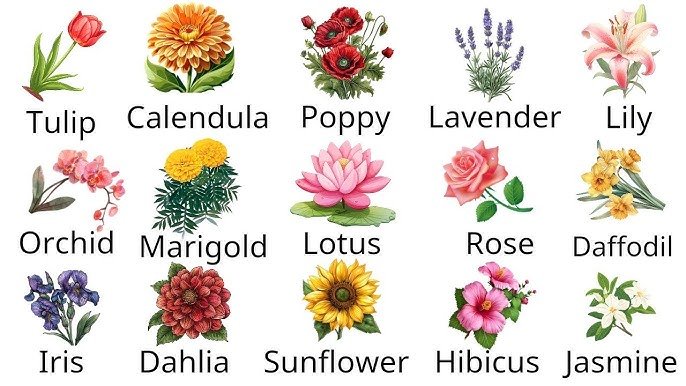Flowers have long been symbols of beauty, love, and nature’s splendor. In the United States, the diversity of climates and landscapes has given rise to a rich tapestry of floral species, each holding unique significance and charm. From the iconic roses of the East Coast to the vibrant sunflowers of the Midwest, the U.S. boasts a plethora of beloved blooms. This guide delves into some of the most popular and culturally significant flowers across the country.
🌹 Roses: The Quintessential American Flower
Scientific Name: Rosa spp.
Roses are perhaps the most iconic flowers in the U.S., symbolizing love, passion, and beauty. They are cultivated extensively across the nation, with various species and hybrids offering a spectrum of colors and fragrances. Roses are especially prevalent in states like New York and Florida, where they are celebrated for their elegance and versatility.
🌻 Sunflowers: The Bright Faces of the Midwest
Scientific Name: Helianthus annuus
Sunflowers are synonymous with the American Midwest. Their towering stems and large, golden petals evoke feelings of warmth and optimism. States such as Kansas and South Dakota have adopted the sunflower as their state flower, reflecting its deep-rooted presence in local culture and agriculture.
🌼 Daisies: Symbols of Purity and Innocence
Scientific Name: Bellis perennis
Daisies are cherished across the U.S. for their simple yet charming appearance. Their white petals and yellow centers symbolize purity and innocence. Daisies are commonly found in gardens and wildflower meadows, thriving in various climates from the Pacific Northwest to the Northeast.
🌷 Tulips: Spring’s Colorful Heralds
Scientific Name: Tulipa spp.
Tulips are among the first flowers to bloom in spring, heralding the end of winter with their vibrant colors. They are particularly popular in states like Michigan and Ohio, where they are celebrated during annual tulip festivals. Tulips come in a myriad of colors, including red, yellow, and purple, adding a burst of color to gardens and landscapes.
🌸 Cherry Blossoms: Nature’s Pink Canopy
Scientific Name: Prunus spp.
Cherry blossoms are renowned for their fleeting beauty and are especially prominent in Washington, D.C., during the National Cherry Blossom Festival. These delicate pink flowers attract visitors from around the world, symbolizing the transient nature of beauty and life.
🌺 Hibiscus: Tropical Elegance
Scientific Name: Hibiscus rosa-sinensis
Hibiscus flowers are native to tropical and subtropical regions and are widely cultivated in states like Hawaii and Florida. Their large, colorful blooms are often associated with tropical beauty and are used in various cultural ceremonies and decorations.
🌾 Lavender: Fragrance of the West
Scientific Name: Lavandula spp.
Lavender is cherished for its soothing fragrance and is commonly found in gardens across the Western United States. It thrives in dry, well-drained soils and is often used in aromatherapy, culinary dishes, and as a natural insect repellent.
🌿 Native Wildflowers: America’s Indigenous Blooms
Each U.S. state boasts its own state flower, many of which are native wildflowers that hold cultural and historical significance. Here are a few notable examples:
- California Poppy (Eschscholzia californica): The vibrant orange poppy is California’s state flower, symbolizing the state’s natural beauty.
- Texas Bluebonnet (Lupinus texensis): This striking blue flower is Texas’s state flower, covering the state’s fields in a sea of blue during spring.
- Alaska’s Forget-Me-Not (Myosotis alpestris): A symbol of remembrance, this delicate blue flower is Alaska’s state flower.
- Hawaii’s Hibiscus (Hibiscus rosa-sinensis): The hibiscus is Hawaii’s state flower, representing the state’s tropical allure.
🌿 Summary
The United States’ diverse climates and landscapes have fostered a rich variety of flowers, each with its unique beauty and symbolism. From the romantic allure of roses to the cheerful faces of sunflowers, these blooms not only enhance the nation’s natural beauty but also reflect its cultural and regional identities. Whether you’re a gardening enthusiast or simply an admirer of nature’s wonders, exploring the flowers of the U.S. offers a delightful journey through color, fragrance, and history.
